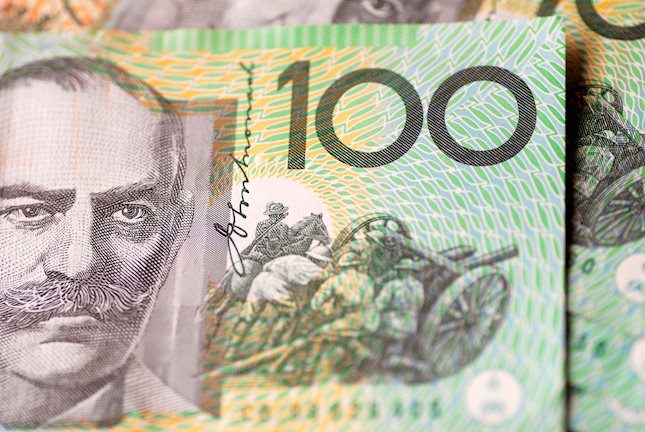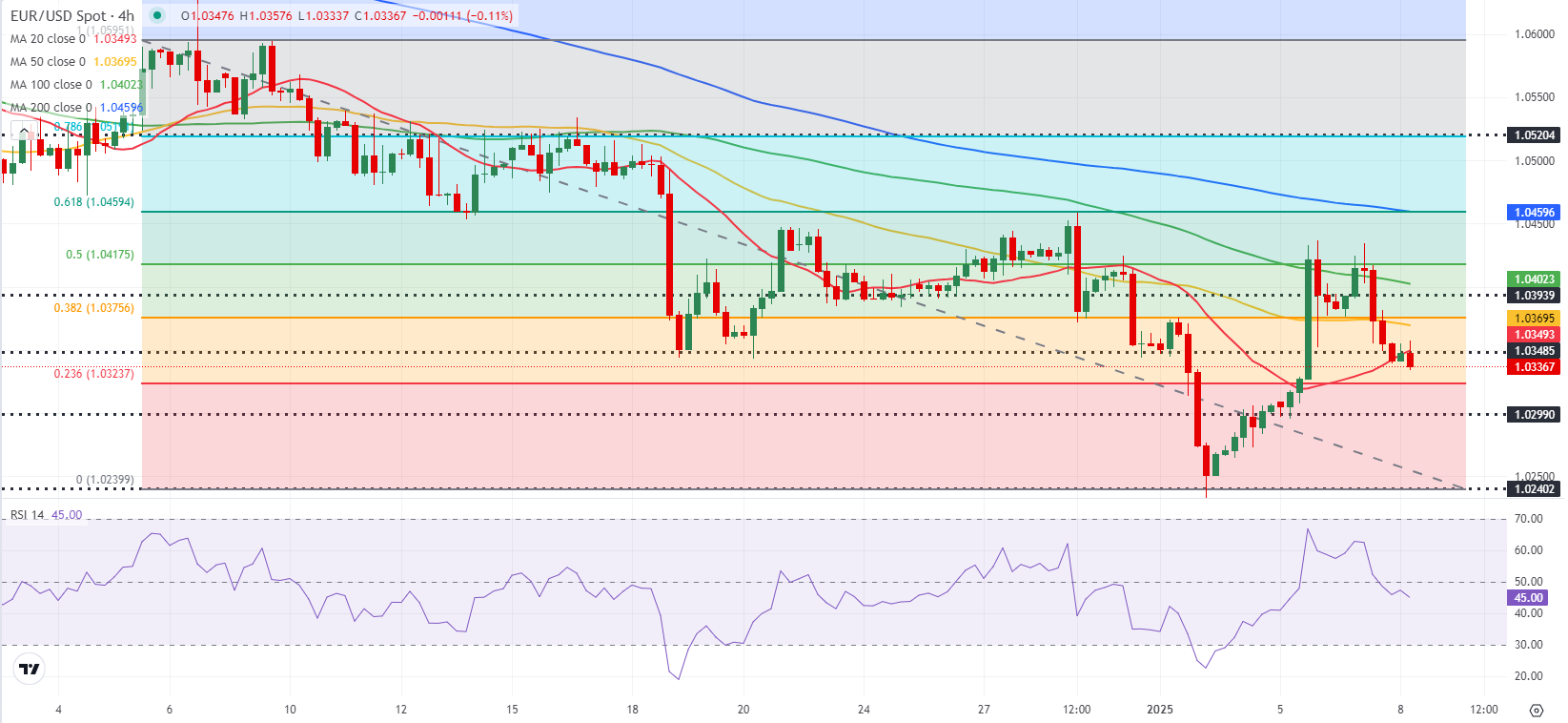- EUR/USD trades slightly below 1.0350 after closing in negative territory on Tuesday.
- The technical outlook highlights buyers' hesitancy in the near term.
- Investors await employment-related US data and FOMC Minutes.
Following Monday's upsurge, EUR/USD reversed its direction on Tuesday and closed in negative territory. The pair stays relatively quiet below 1.0350 in the European morning on Wednesday.
Euro PRICE Today
The table below shows the percentage change of Euro (EUR) against listed major currencies today. Euro was the weakest against the US Dollar.
| USD | EUR | GBP | JPY | CAD | AUD | NZD | CHF | |
|---|---|---|---|---|---|---|---|---|
| USD | 0.11% | 0.12% | 0.13% | 0.03% | 0.13% | 0.13% | 0.12% | |
| EUR | -0.11% | 0.01% | 0.00% | -0.08% | 0.03% | 0.03% | 0.02% | |
| GBP | -0.12% | -0.01% | 0.02% | -0.09% | 0.02% | 0.02% | 0.00% | |
| JPY | -0.13% | 0.00% | -0.02% | -0.10% | 0.00% | -0.01% | -0.00% | |
| CAD | -0.03% | 0.08% | 0.09% | 0.10% | 0.10% | 0.10% | 0.09% | |
| AUD | -0.13% | -0.03% | -0.02% | -0.01% | -0.10% | -0.00% | -0.01% | |
| NZD | -0.13% | -0.03% | -0.02% | 0.00% | -0.10% | 0.00% | -0.01% | |
| CHF | -0.12% | -0.02% | -0.01% | 0.00% | -0.09% | 0.01% | 0.00% |
The heat map shows percentage changes of major currencies against each other. The base currency is picked from the left column, while the quote currency is picked from the top row. For example, if you pick the Euro from the left column and move along the horizontal line to the US Dollar, the percentage change displayed in the box will represent EUR (base)/USD (quote).
The US Dollar (USD) benefited from the negative shift seen in risk mood and upbeat macroeconomic data releases on Tuesday, forcing EUR/USD to push lower. The ISM Services PMI improved to 54.1 in December from 52.1 in November, pointing to an ongoing expansion in the services sector's activity at an accelerating pace. Additionally, JOLTS Job Openings rose to 8.09 million in November from 7.84 million in October. Both of these figures came in better than analysts' estimates.
On Wednesday, ADP Employment Change data from the US will be watched closely by investors. The market expectation is for private sector payrolls to rise 140,000 in December following the 146,000 increase recorded in November. A reading above 150,000 could support the USD, while a disappointing print below 130,000 could have the opposite effect on the currency's valuation.
Later in the American session, the Federal Reserve will publish the minutes of the December policy meeting. Unless there is a dovish surprise in the publication, the USD is likely to stay resilient against its rivals.
EUR/USD Technical Analysis
The Relative Strength Index (RSI) indicator on the 4-hour retreated slightly below 50, reflecting buyers' hesitancy. Additionally, EUR/USD closed the last three 4-hour candles below the 20-period and the 50-period Simple Moving Averages (SMA).
On the downside, 1.0320 (Fibonacci 23.66% retracement level of the latest downtrend) aligns as first support before 1.0300 (round level, static level) and 1.0240 (end-point of the downtrend). Looking north, resistances could be spotted at 1.0370 (50-period SMA, Fibonacci 38.2% retracement), 1.0400 (100-period SMA) and 1.0420 (Fibonacci 50% retracement).
Euro FAQs
The Euro is the currency for the 19 European Union countries that belong to the Eurozone. It is the second most heavily traded currency in the world behind the US Dollar. In 2022, it accounted for 31% of all foreign exchange transactions, with an average daily turnover of over $2.2 trillion a day. EUR/USD is the most heavily traded currency pair in the world, accounting for an estimated 30% off all transactions, followed by EUR/JPY (4%), EUR/GBP (3%) and EUR/AUD (2%).
The European Central Bank (ECB) in Frankfurt, Germany, is the reserve bank for the Eurozone. The ECB sets interest rates and manages monetary policy. The ECB’s primary mandate is to maintain price stability, which means either controlling inflation or stimulating growth. Its primary tool is the raising or lowering of interest rates. Relatively high interest rates – or the expectation of higher rates – will usually benefit the Euro and vice versa. The ECB Governing Council makes monetary policy decisions at meetings held eight times a year. Decisions are made by heads of the Eurozone national banks and six permanent members, including the President of the ECB, Christine Lagarde.
Eurozone inflation data, measured by the Harmonized Index of Consumer Prices (HICP), is an important econometric for the Euro. If inflation rises more than expected, especially if above the ECB’s 2% target, it obliges the ECB to raise interest rates to bring it back under control. Relatively high interest rates compared to its counterparts will usually benefit the Euro, as it makes the region more attractive as a place for global investors to park their money.
Data releases gauge the health of the economy and can impact on the Euro. Indicators such as GDP, Manufacturing and Services PMIs, employment, and consumer sentiment surveys can all influence the direction of the single currency. A strong economy is good for the Euro. Not only does it attract more foreign investment but it may encourage the ECB to put up interest rates, which will directly strengthen the Euro. Otherwise, if economic data is weak, the Euro is likely to fall. Economic data for the four largest economies in the euro area (Germany, France, Italy and Spain) are especially significant, as they account for 75% of the Eurozone’s economy.
Another significant data release for the Euro is the Trade Balance. This indicator measures the difference between what a country earns from its exports and what it spends on imports over a given period. If a country produces highly sought after exports then its currency will gain in value purely from the extra demand created from foreign buyers seeking to purchase these goods. Therefore, a positive net Trade Balance strengthens a currency and vice versa for a negative balance.
Information on these pages contains forward-looking statements that involve risks and uncertainties. Markets and instruments profiled on this page are for informational purposes only and should not in any way come across as a recommendation to buy or sell in these assets. You should do your own thorough research before making any investment decisions. FXStreet does not in any way guarantee that this information is free from mistakes, errors, or material misstatements. It also does not guarantee that this information is of a timely nature. Investing in Open Markets involves a great deal of risk, including the loss of all or a portion of your investment, as well as emotional distress. All risks, losses and costs associated with investing, including total loss of principal, are your responsibility. The views and opinions expressed in this article are those of the authors and do not necessarily reflect the official policy or position of FXStreet nor its advertisers. The author will not be held responsible for information that is found at the end of links posted on this page.
If not otherwise explicitly mentioned in the body of the article, at the time of writing, the author has no position in any stock mentioned in this article and no business relationship with any company mentioned. The author has not received compensation for writing this article, other than from FXStreet.
FXStreet and the author do not provide personalized recommendations. The author makes no representations as to the accuracy, completeness, or suitability of this information. FXStreet and the author will not be liable for any errors, omissions or any losses, injuries or damages arising from this information and its display or use. Errors and omissions excepted.
The author and FXStreet are not registered investment advisors and nothing in this article is intended to be investment advice.
Recommended Content
Editors’ Picks

AUD/USD keeps the red near 0.6200 after Chinese inflation data
AUD/USD keeps losses near the 0.6200 mark following mixed Australian data and as expected China's inflation numbers. The RBA's dovish shift and China's economic woes add to the weight on the Aussie as risk sentiment remains tepid. Fedspeak eyed.

USD/JPY: Bears attack 158.00 on strong Japanese wage growth data
USD/JPY drifts lower to test 158.00 early Thursday after data showed that base salaries for Japanese workers increased at the fastest pace in 32 years. The data backs the case for the BoJ to raise interest rates, which, along with the cautious market mood, benefits the safe-haven Yen and drags the pair away from a multi-month top.

Gold price retreats toward $2,650 despite risk aversion
Gold price is retreating from near a monthly high of $2,670 in Thursday's Asian trading. Resurgent haven demand for the US Dollar amid risk aversion weigh on Gold price even as US Treausry bond yields extend pullback. Focus shifts to Fedspeak amid holiday-thinned trading.

Has Bitcoin topped for the cycle? Here's what key metrics suggest
Bitcoin experienced a 2% decline on Wednesday as the cryptocurrency market grapples with recent losses. On-chain data has indicated a shift in the accumulation of the leading cryptocurrency, suggesting that holders are increasingly selling their assets.

Bitcoin edges below $96,000, wiping over leveraged traders
Bitcoin's price continues to edge lower, trading below the $96,000 level on Wednesday after declining more than 5% the previous day. The recent price decline has triggered a wave of liquidations across the crypto market, resulting in $694.11 million in total liquidations in the last 24 hours.

Best Forex Brokers with Low Spreads
VERIFIED Low spreads are crucial for reducing trading costs. Explore top Forex brokers offering competitive spreads and high leverage. Compare options for EUR/USD, GBP/USD, USD/JPY, and Gold.
